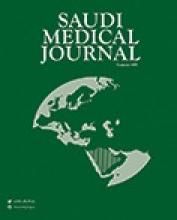Abstract
OBJECTIVE: This study aimed to assess the prevalence of risk factors, knowledge and awareness in Pakistani patients with type 2 diabetes mellitus (DM).
METHODS: We studied 120 DM patients at the Diabetes Center in Rawalpindi, Pakistan, from February 2001 to July 2001. Structured questionnaires, clinical and laboratory assessments were used to determine the prevalence of dyslipidemia, glycemic control, hypertension, self monitoring of blood glucose, treatment for hyperglycemia, smoking and modes of diagnosis. The patients knowledge was assessed as regards to the laboratory investigations and treatment of DM that they are receiving. Fasting blood samples were analyzed for serum total cholesterol, triglycerides, low-density lipoprotein cholesterol (LDL-C), high-density lipoprotein cholesterol (HDL-C), glucose and glycosylated hemoglobin (HbA1c).
RESULTS: It was found that 46.7% of subjects had poor glycemic control (HbA1c >7.5%). There was a higher prevalence of obesity (body mass index >30) in females (30%) as compared to males (11.4%). Approximately 56.7% of subjects had moderate to high-risk levels of serum total cholesterol, LDL-C 66.7%, HDL-C 46.7% and triglycerides 16.7%. Prevalence of hypertension was 48.3% (41.7% had systolic and 28.3% had diastolic hypertension). Approximately 46% of hypertensive subjects were unaware of their hypertension. The prevalence of hypertension was higher in patients who had a positive family history of DM. On regression analysis, poor glycemic control (raised HbA1c levels) was positively related with total cholesterol (coefficient correlation [r] = 0.24) (p<0.05) and LDL-C [r = 0.28] (p<0.05) levels and negatively related with HDL-C [r = 0.49] (p<0.0001).
CONCLUSION: There is a high prevalence of poor glycemic control and atherogenic dyslipidemia in Pakistani patients with type 2 DM. Most of these diabetics have poor knowledge of their disease and are unaware of its complications.
- Copyright: © Saudi Medical Journal
This is an open-access article distributed under the terms of the Creative Commons Attribution-Noncommercial-Share Alike 3.0 Unported, which permits unrestricted use, distribution, and reproduction in any medium, provided the original work is properly cited.






